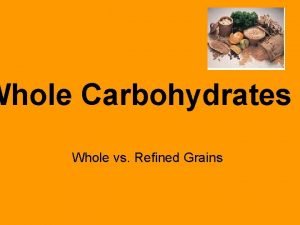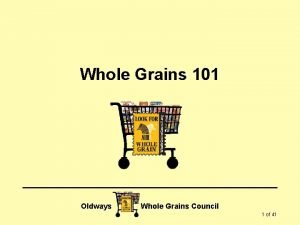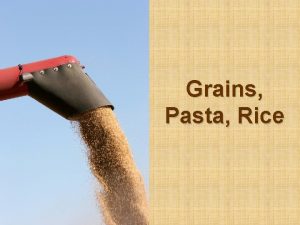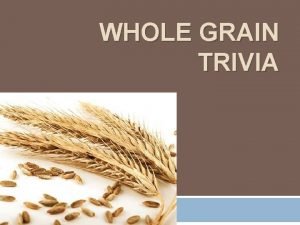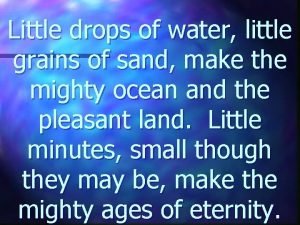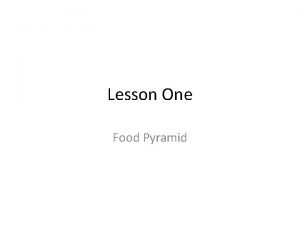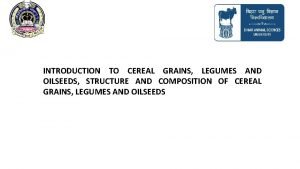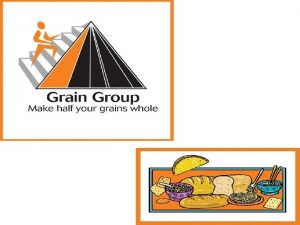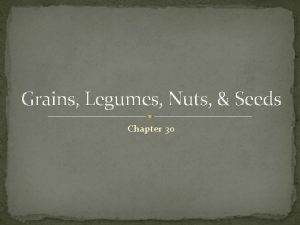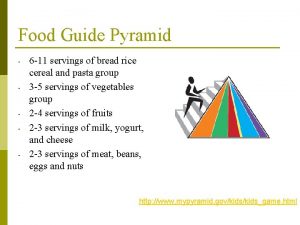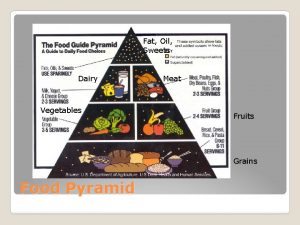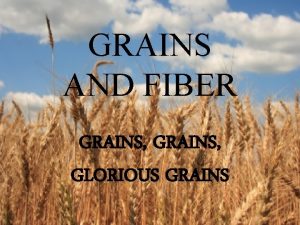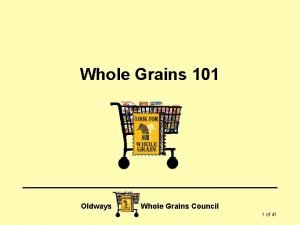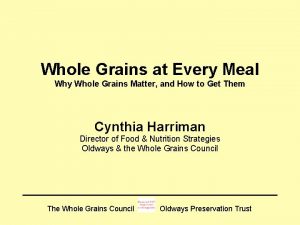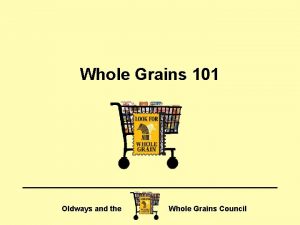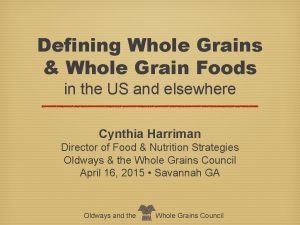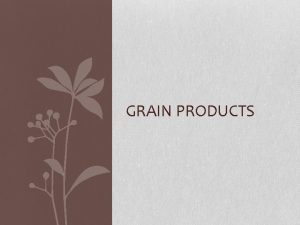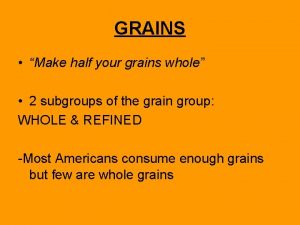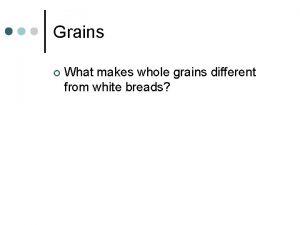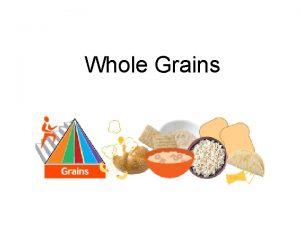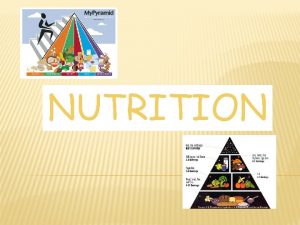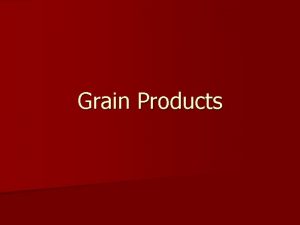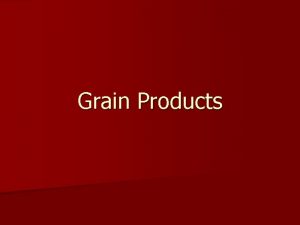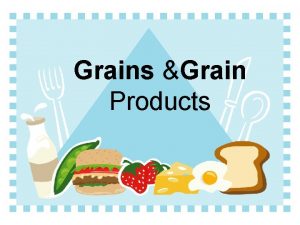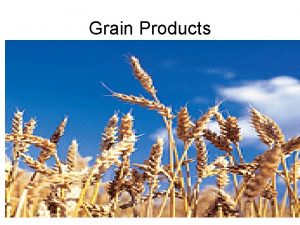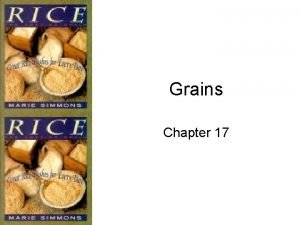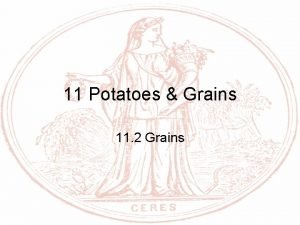Grain Products Whole grains are good sources of



























- Slides: 27

Grain Products Whole grains are good sources of nutrients, energy and fiber. Economical, easy to store and easy to prepare.

Cereals - starchy grains used as food. n n n Wheat Corn Rice Oats Barley Rye

n Cereals can be prepared and eaten in their natural form OR n Cereals can be used to make cereal products § Flour § Pasta § Breakfast cereals § Muffins § Bread

Cereals are a major part of diets around the world n Nutrients n Carbohydrates Starch n Fiber n n B vitamins – thiamin, niacin, riboflavin, folic acid Iron Protein – if combined with meat, dairy products or other cereals

Cereal Products n Flour –made by grinding grains into powder n n n Can be made from any grain Wheat is the most commonly used in the U. S. Used mainly to make baked products like bread Also used as thickener in sauces, soups, and gravies Can be made from whole grain or part of grain n Parts of grain removed – refined n n Fiber, iron, and B vitamins are removed Enriched cereal products have iron and B vitamins added back n Fiber is not put back in

n Different flours have different flavors and textures n All-purpose – general cooking and baking n n Cake – milled more finely than other flours n n Used for delicately textured cakes Self-rising – contains a leavening agent and salt n n Used when a recipe merely calls for flour Often used when making quick breads Whole wheat – made from the entire grain kernel, has a coarser texture than other flours n Used in breads – gives a coarser texture and nuttier flavor

n Pasta – made from a flour paste n n Uses a special wheat flour (semolina) made from durum wheat to maintain shape Macaroni, spaghetti, noodle Shapes – shells, bows, corkscrews Other ingredients to add flavor and appearance Noodles – eggs or egg yolks n Pasta – spinach and tomatoes § Pasta with fillings (cheese & meat) n - - Ravioli Tortellini Most pastas are enriched with thiamin, niacin, riboflavin, folic acid and iron

§ Sold in several forms § Dried – most common § § § Fresh – refrigerated or frozen in many markets § § more expensive than dried Packages with pasta and sauce mixes § § inexpensive easy to store (cool, dry cabinet) Example: macaroni & cheese Frozen in sauces § Convenient but expensive

n Rice n White rice is produced when the bran layer is removed n n Needs to be enriched (nutrients added back in b/c removed) Brown rice is whole grain rice Higher in fiber than white rice n Nutty flavor and more chewy than white rice n n n Long grain rice – cooks to a fluffy texture, grains more likely to stay separated Short/medium grain rice tend to cling together when cooked

n Instant/precooked rice Has been fully cooked and dried n Takes only a few minutes to prepare n Costs more than regular rice n n Wild rice – seed from wild grasses that grow in marshes (not rice) Nutty flavor n More expensive than rice n Often mixed w/ brown rice to lower the cost n

n Breakfast Cereals n n n From wheat, oats, corn and rice Ready-to-eat and cooked Read labels to determine nutrient value n n Ready to eat cereal is more expensive than cereals that require cooking n n n May be high in sugar and contain fat May be low in fiber In general, whole grain, enriched and fortified cereals are nutritious Cereals with dried fruits or nuts added and presweetened cereals are more costly than plain cereals. Quick cooking and instant cereals are more costly Compare cost per serving not by weight of package n Note serving size

n Breads n n White, whole wheat, rye, oatmeal, pumpernickel, and raisin Variety of forms n Rolls, buns, muffins, and bagels n Look for freshness dates on package n Commercially prepared n n n Fresh baked n n n Prepackaged and sold in grocery store Produced in large quantities and fairly inexpensive Bakeries and bakery section of grocery store Costs more than commercially produced Convenience Bread Products n n n Brown & Serve – partially baked Refrigerated dough Frozen dough – thaw and bake n n Needs time to rise before baking Vary in price - more than making from scratch but less than prebaked

Storing Cereal Products n n n Most can be stored in tightly sealed containers, in a cool dry place Breakfast cereals can be stored 2 -3 months under proper conditions Brown and wild rice keep about 6 months Refined flour, white rice, and pasta keeps up to one year Whole grain products do not last as long b/c they contain fat – store in fridge for longer freshness Breads can be stored about 1 week in a cool, dry place n n Can be stored in refrigerator for about 3 weeks Can be frozen for several months – wrap tightly Be sure package is tightly sealed wherever bread is stored Cakes and cookies with perishable fillings and frostings will need refrigeration

Cooking Starches & Cereals n n Directions for cooking cereal products are usually listed on package Tips for cooking cereal products n n When water and starch are heated, the starch granules swell, absorb water and become soft and thick (gelatinization) Gelatinization causes cereal products to increase in volume n Consider when deciding how much to cook n n n Temperature is important n n White rice triples in volume Brown rice quadruples in volume Pasta doubles in volume Oatmeal triples in volume Too low starch granules will not swell Too high starch granules form lumps Gentle stirring to prevent lumps Overstirring causes the granules to break down

Starch as a Thickener Starch is the complex carbohydrate part of plants; the major portion of grain products n Most common thickeners n n Cornstarch Flour n Used to make n n Gravy Sauce Pudding Pie fillings

n Main challenge of using starch as a thickener is preventing lumps n Three methods to keep starch granules separated n Coat starch with melted fat to make a paste then add liquid slowly, stirring constantly n n Combine starch with sugar then stir in liquid slowly n n Pudding and pie fillings Mix starch with a cold liquid to form a paste, slowly stir the paste into the hot liquid n n Cheese sauces Gravy All require constant stirring

Cooking Pasta n Boil in a large amount of water n n n 2 quarts of water per 8 ounces of pasta Use deep pot so water does not boil over Water should be boiling rapidly before adding pasta to keep it from sticking together n n n Pasta is done when it no longer has a hard white center n Test by tasting n n n Add pasta a little at a time to keep water boiling A little butter or oil added to the water also helps keep pasta from sticking together Should be a little chewy but not crunchy Should not be overcooked and mushy Drain cooked pasta in colander n May be rinsed but not recommended n Looses nutrients

Cooking Rice n n Often add seasonings and sauces for flavor Long cooking rice n n n Use twice as much water as rice Combine water, rice, and seasonings in saucepan Use pan large enough to accommodate increased volume of cooked rice Bring to boil, reduce heat to simmer and cover with a lid Follow package directions for cooking time Instant rice n n n Boil water, butter, and salt Remove from heat, add rice, and cover Let stand for time indicated on package

Cooked Cereals n Oatmeal, grits n n Add cereal slowly to boiling water, stirring constantly Cook for time indicated on package

Microwaving Cereal Products n n Rice, pasta, and breakfast cereals can all be cooked in the microwave Cereals cooked in the microwave take the same amount of time to cook as on the range n n n Less likely to burn in microwave Can be prepared and served in the same microwavable dish Choose large enough dish to allow for boiling and swelling of cereal Dish should be covered during cooking After cooking, leave rice and cereal products stand n n Stand time allows rice and cereal to continue cooking Pasta does not need stand time

Making Breads n Baked products rise because air, steam, and carbon dioxide become trapped in the product n n n Air is incorporated during mixing Steam is formed when liquid ingredients are heated as the product bakes Carbon dioxide is produced by leavening agents used as ingredients Quick breads use baking powder or baking soda n Yeast breads use yeast n

Quick Breads n n n n Muffins Nut breads Waffles Pancakes Biscuits Popovers Cream puffs n Leavening agents n n Baking powder & baking soda Pour Batter – thin, enough liquid to be pourable (pancakes, waffles) Drop Batter – thick (muffins, drop biscuits, coffee cakes) Soft Dough – sticky, stiff, thick mixture (rolled biscuits, dumplings)

Quick Breads n Biscuits Method of preparation n Combine dry ingredients n Cut shortening into dry ingredients n n n Add liquid ingredients and mix n n n Will look like small peas Use pastry blender or two knives or even your hands Should look rough and lumpy Knead until fairly smooth on lightly floured surface Roll, cut or shape as directed Bake immediately Too much mixing or kneading will cause dough to become tough

Quick Breads n Muffins Method of Preparation n n Combine dry ingredients in one bowl Combine liquid ingredients in a separate bowl Make a well in the center of dry ingredients Pour liquid ingredients into well (dry ingredients) Mix only until all ingredients are moist n n n If making muffins n n n There should be lumps Quick breads become tough if mixed until lumps are gone Place batter into muffin tins that have paper liners or that have been greased Fill only 2/3 rds full Bake in preheated oven immediately n If not set muffins will not rise completely

Quick Breads n Preparing Pancakes & Waffles n Mix batter in same way muffin batter is prepared n n Pancake & waffle batter are thinner than muffin batter Cooking surface should be hot so that outside browns and inside becomes fluffy inside Pancakes are turned when little bubbles appear on surface Waffles are done when steam no longer comes out of the waffle iron

Yeast Breads n Use yeast as the leavening agent n Yeast - a tiny plant that produces carbon dioxide when mixed with the right ingredients n n n Carbon dioxide is what makes the bread rise Rising takes time Preparation n n Mix warm liquid, sugar, and yeast Add flour and other ingredients Allow mixed dough to rest ten minutes Knead dough on floured surface n n Push dough away with heel of hand Turn dough ¼ turn Fold dough in half toward self Repeat until smooth and elastic

Place dough in greased bowl and cover with dish towel n Rise until doubled in size n Test by pushing two fingers into dough n If dough stays indented, it has risen enough Punch down by pushing a fist into dough n Releases carbon dioxide gas n n Some yeast breads are allowed to rise a second time and punched down again n Shape dough as described in recipe n Allow dough to rise until double in size n Bake according to recipe n Breads are done when they are golden brown and sound hollow when tapped n Remove bread from pans immediately and cool on cooling racks n n Will become soggy if not immediately removed from pan
 Refined grain bread
Refined grain bread Antigentest åre
Antigentest åre Cdc whole school whole community whole child
Cdc whole school whole community whole child Whole grain
Whole grain Wheat germ is the whole grain minus the husk.
Wheat germ is the whole grain minus the husk. Grains are types of grasses. true false
Grains are types of grasses. true false Massed practice
Massed practice Print sources of information
Print sources of information Importance of water management
Importance of water management Zoroastrianism good thoughts good deeds
Zoroastrianism good thoughts good deeds Hello and good evening
Hello and good evening Good afternoon buenas tardes
Good afternoon buenas tardes You are good you are good when there's nothing good in me
You are good you are good when there's nothing good in me Buenas tardes
Buenas tardes Fisher's functional vs innovative products
Fisher's functional vs innovative products Quechuc
Quechuc Defining a research problem
Defining a research problem What is natural nitrogen fertilizer
What is natural nitrogen fertilizer Grains webquest
Grains webquest Angular grains
Angular grains A student determined that exactly 10 pollen grains
A student determined that exactly 10 pollen grains Little drops of water make a mighty ocean paragraph
Little drops of water make a mighty ocean paragraph Food pyramid questions
Food pyramid questions Legumes and oilseeds
Legumes and oilseeds One serving of grains
One serving of grains What are grains
What are grains 6-11 servings of grains
6-11 servings of grains Dairy meat fruit vegetables and grains
Dairy meat fruit vegetables and grains
